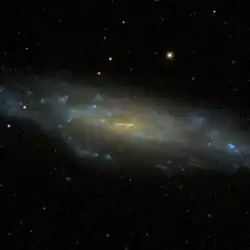| NGC 3003 | |
|---|---|
 SDSS image of NGC 3003 | |
| Observation data (J2000 epoch) | |
| Constellation | Leo Minor |
| Right ascension | 09h 48m 35.580s[1] |
| Declination | +33° 25′ 17.83″[1] |
| Redshift | 0.004930[1] |
| Heliocentric radial velocity | 1474 km/s[1] |
| Distance | 63.6 Mly (19.50 Mpc)[2] |
| Apparent magnitude (V) | 11.78[3] |
| Apparent magnitude (B) | 12.25[3] |
| Characteristics | |
| Type | SBbc[3] |
| Other designations | |
| UGC 5251, MCG +06-22-013, PGC 28186[1] | |
NGC 3003 is a nearly edge-on barred spiral galaxy in the constellation of Leo Minor, discovered by William Herschel on December 7, 1785.[4] It has an apparent visual magnitude of 11.78,[3] at a distance of 19.5 Mpc from the Sun.[2] It has a recessional velocity of 1474 km/s.[1]
In 1961, a type II supernova with an apparent magnitude of 13.0 was detected within the galaxy, and was subsequently designated SN 1961F.[5]
References
- 1 2 3 4 5 6 "NGC 3003". SIMBAD. Centre de données astronomiques de Strasbourg. Retrieved 2021-02-10.
- 1 2 Tully, R. Brent; Courtois, Hélène M.; Sorce, Jenny G. (2016). "Cosmicflows-3". The Astronomical Journal. 152 (2): 21. arXiv:1605.01765. Bibcode:2016AJ....152...50T. doi:10.3847/0004-6256/152/2/50. S2CID 250737862. 50.
- 1 2 3 4 "Search specification: NGC 3003". HyperLeda. Université Claude Bernard Lyon 1. Retrieved 2021-02-10.
- ↑ "New General Catalog Objects: NGC 3000 - 3049". cseligman.com.
- ↑ "SN 1961F". SIMBAD. Centre de données astronomiques de Strasbourg. Retrieved 2021-02-10.
External links
 Media related to NGC 3003 at Wikimedia Commons
Media related to NGC 3003 at Wikimedia Commons
This article is issued from Wikipedia. The text is licensed under Creative Commons - Attribution - Sharealike. Additional terms may apply for the media files.